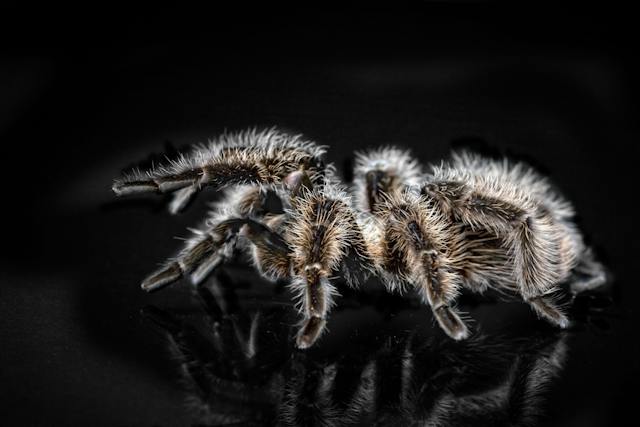The curly hair Tarantula, also known as a woolly Tarantula, is round in shape with hairy legs. It owes its name to the long bristles that end in a slight curl. The hairs are dark brown or blackish, though some appear with a golden tint.
The colorful appearance attracts the spider as a pet as it emits a bronze glow that pet owners like. These burrowing spiders are predominantly land-dwellers and are believed to have originated in Central America.
While handling them, be as gentle as you can. If you drop your pet while standing, it can get severely injured or even die. Hence, it is safer to handle a Tarantula while sitting down.
Tarantulas as Pets
Today, many of these Tarantulas are reared in captivity as pets. These calm creatures are easy to handle, and anyone can raise them as pets. It is best to create a pet enclosure that is similar to its natural habitat.
A pet Tarantula needs to be fed live insects as it doesn’t feed on dead insects. Unlike most spiders, which are considered creepy and weird creatures, Tarantulas are loved by all pet lovers.
Behavior and Temperament
The curly hair Tarantulas are docile creatures that make excellent pets. Don’t be disappointed if you expected a playful and lively pet in a spider because these are quiet creatures that like to be left alone. These Tarantulas want to spend hours together in a restful state unless they are hungry.
Don’t try to handle them too often as they tend to get agitated quickly, though some of them will rest on your palm, motionless if you are gentle and don’t make any jerky movements. Take care not to drop them from a height (while standing) as they can get injured and might even die of a fall. It is best to sit down while handling your pet spider.
Whenever these Tarantulas are disturbed or feel threatened, they tend to become aggressive, and their hairs stand on end. The spider’s hair can irritate your skin, and in some cases, it can turn allergic. It is advisable to wash your hands each time you handle your curly hair Tarantula. Moreover, its bite is mildly venomous and can cause pain and mild swelling.
Housing
Design an enclosure that replicates a Tarantula’s natural habitat. The enclosure can be in glass, metal, or plastic. However, it should be wide and high enough for your pet to move around freely. A norm is that the width should be two to three times the leg span of a Tarantula.
The floor can be covered with 3 to 4 inches of soft soil or peat-moss with a few pebbles strewn around. Adding a few twigs, small branches, tiny logs, and leaves will make the enclosure realistic as a Tarantula’s original habitat. Maintain a temperature of between 75 to 85 degrees F, and use heaters if required.
Feeding
A Tarantula prefers live insects like tiny crickets, roaches, earthworms, and other insects. Ensure that the live insects you feed your pet spider are smaller in size than your Tarantula, though adults love eating pinky mice. They feed once in three to four days and seldom eat while molting.
Evening times are best feeding times for your spider, and if it refuses to eat occasionally, don’t panic as it is quite common. You may provide a small water dish, though they seldom drink as they get hydrated with the solid food they eat.
Tarantulas generally enjoy good health and are known to live for several years. However, if your pet doesn’t eat for more than a week, check with your vet and follow their advice.
Summing it Up
Curly hair Tarantulas make excellent pets; though it is crucial to keep them away from other pets, you may be rearing. They are very reclusive and spend most of their time doing nothing other than feeding and weaving their webs.

